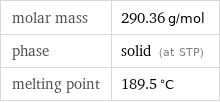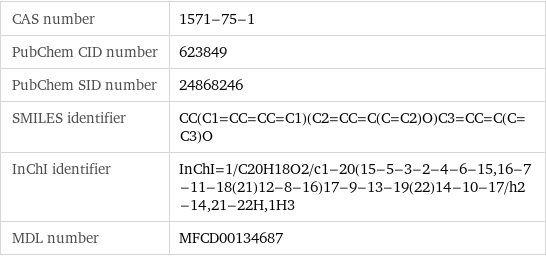Input interpretation

4, 4'-(1-phenylethylidene)bisphenol
Chemical names and formulas
![formula | CH_3C(C_6H_5)(C_6H_4OH)_2 Hill formula | C_20H_18O_2 name | 4, 4'-(1-phenylethylidene)bisphenol IUPAC name | 4-[1-(4-hydroxyphenyl)-1-phenylethyl]phenol alternate names | 4-[1-(4-hydroxyphenyl)-1-phenyl-ethyl]phenol | 4-[1-(4-hydroxyphenyl)-1-phenylethyl]phenol | bisphenol AP mass fractions | C (carbon) 82.7% | H (hydrogen) 6.25% | O (oxygen) 11%](../image_source/3a1538ef5d2cc50115e9fdf91746fb80.png)
formula | CH_3C(C_6H_5)(C_6H_4OH)_2 Hill formula | C_20H_18O_2 name | 4, 4'-(1-phenylethylidene)bisphenol IUPAC name | 4-[1-(4-hydroxyphenyl)-1-phenylethyl]phenol alternate names | 4-[1-(4-hydroxyphenyl)-1-phenyl-ethyl]phenol | 4-[1-(4-hydroxyphenyl)-1-phenylethyl]phenol | bisphenol AP mass fractions | C (carbon) 82.7% | H (hydrogen) 6.25% | O (oxygen) 11%
Lewis structure

Draw the Lewis structure of 4, 4'-(1-phenylethylidene)bisphenol. Start by drawing the overall structure of the molecule, ignoring potential double and triple bonds: Count the total valence electrons of the carbon (n_C, val = 4), hydrogen (n_H, val = 1), and oxygen (n_O, val = 6) atoms: 20 n_C, val + 18 n_H, val + 2 n_O, val = 110 Calculate the number of electrons needed to completely fill the valence shells for carbon (n_C, full = 8), hydrogen (n_H, full = 2), and oxygen (n_O, full = 8): 20 n_C, full + 18 n_H, full + 2 n_O, full = 212 Subtracting these two numbers shows that 212 - 110 = 102 bonding electrons are needed. Each bond has two electrons, so in addition to the 42 bonds already present in the diagram add 9 bonds. To minimize formal charge carbon wants 4 bonds. Identify the atoms that want additional bonds and the number of electrons remaining on each atom: Fill in the 9 bonds by pairing electrons between adjacent highlighted atoms. Note that the six atom rings are aromatic, so that the single and double bonds may be rearranged: Answer: | |
3D structure

3D structure
Basic properties

molar mass | 290.36 g/mol phase | solid (at STP) melting point | 189.5 °C
Units

Chemical identifiers

CAS number | 1571-75-1 PubChem CID number | 623849 PubChem SID number | 24868246 SMILES identifier | CC(C1=CC=CC=C1)(C2=CC=C(C=C2)O)C3=CC=C(C=C3)O InChI identifier | InChI=1/C20H18O2/c1-20(15-5-3-2-4-6-15, 16-7-11-18(21)12-8-16)17-9-13-19(22)14-10-17/h2-14, 21-22H, 1H3 MDL number | MFCD00134687